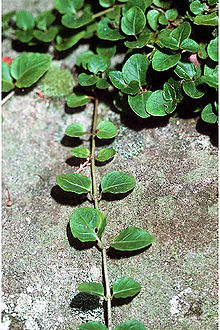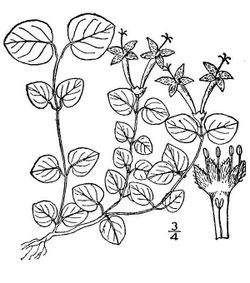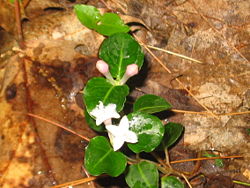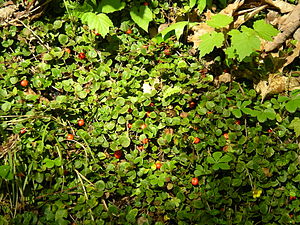- Mitchella repens
-
Partridge Berry 
Scientific classification Kingdom: Plantae (unranked): Angiosperms (unranked): Eudicots (unranked): Asterids Order: Gentianales Family: Rubiaceae Genus: Mitchella Species: M. repens Binomial name Mitchella repens
L.Mitchella repens , or Partridge Berry,[1][2][3][4] or Squaw Vine, is the best known plant in the genus Mitchella. It is a creeping prostrate herbaceous woody shrub, occurring in North America and Japan, and belonging to the madder family (Rubiaceae).
Contents
Taxonomy
Mitchella repens is one of the many species first described by Carl Linnaeus. Its species name is the Latin adjective repens "creeping". Common names for Mitchella repens include partridge berry (or partridgeberry), squaw berry (or squaw berry), two-eyed berry, running fox, and Noon kie oo nah yeah (in the Mohawk language).
Description
Partridge Berry is an evergreen plant growing as a non-climbing vine, no taller than 6 cm tall with creeping stems 15 to 30 cm long. The evergreen, dark green, shiny leaves are ovate to cordate in shape. The leaves have a pale yellow midrib. The petioles are short, and the leaves are paired oppositely on the stems. Adventitious roots may grow at the nodes;[5] and rooting stems may branch and root repeatedly, producing loose spreading mats.
The small, trumpet-shaped, axillary flowers are produced in pairs, and each flower pair arises from one common calyx which is covered with fine hairs. Each flower has four white petals, one pistil, and four stamens. Partridge Berry is a distylous taxa. The plants have either flowers with long pistils and short stamens (long-styled flowers, called the pin), or have short pistils and long stamens (short-styled flowers, called the thrum).[6] The two style morphs are genetically determined, so the pollen from one morph does not fertilize the other morph, resulting in a form of heteromorphic self-incompatibility.[7]
The ovaries of the twin flowers fuse, so that there were two flowers for each berry. The two bright red spots on each berry are vestiges of this process. The fruit ripens between July and October, and may persist through the winter. The fruit is a drupe containing up to eight seeds. The fruits are never abundant. They may be part of the diets of several birds, such as Ruffed Grouse, Sharp-tailed Grouse, Northern Bobwhite, and Wild turkey. They are also consumed by foxes, White-footed mice, and skunks.[8][9] The foliage is occasionally consumed by White-tailed deer.[10]
The common reproduction is vegetative, with plants forming spreading colonies.[11]
Distribution and habitat
The species is dispersed throughout eastern North America, from south Eastern Canada south to Florida and Texas, and to Guatemala. It is found growing in dry or moist woods, along stream banks and on sandy slopes.
Cultivation and uses
Mitchella repens is cultivated for its ornamental red berries and shiny, bright green foliage.[11] It is grown as a creeping ground cover in shady locations. It is rarely propagated for garden use by way of seeds but cuttings are easy.[12] The plants have been widely collected for Christmas decorations, and over collecting has impacted some local populations negatively.[11] American Indian women made a tea from the leaves and berries that was consumed during childbirth.[11] The plants are sometimes grown in terrariums.[13] The scarlet berries are edible but rather tasteless, with a faint flavour of wintergreen, resembling cranberries (to which they are not closely related).
References
- ^ Peterson, Roger Tory, and McKenny, Margaret. A Field Guide to Wildflowers of Northeastern and North-central North America. ISBN 0-395-91172-9.
- ^ MacKenzie, David, S. Perennial Ground Covers. ISBN 0-88192-557-8.
- ^ Hutchens, Alma R. Indian Herbalogy of North America. ISBN 0-87773-639-1.
- ^ Hall, Joan Houston (2002). Dictionary of American Regional English. Harvard University Press. p. 47. ISBN 0-674-00884-7. http://books.google.com/books?id=i33BWgxbvXgC&pg=PA47&dq=%22Gaultheria+procumbens%22+partridgeberry&as_brr=3&ei=n3c_R42aOIKq6ALhm_jTDA&sig=TephPF-NpndJ_sCuNKIf_5Ghww4. Retrieved 2007-11-16.
- ^ Nathaniel Lord Britton; Addison Brown (1913). An illustrated flora of the northern United States, Canada and the British possessions: from Newfoundland to the parallel of the southern boundary of Virginia, and from the Atlantic Ocean westward to the 102d meridian. C. Scribner's sons. pp. 255–. http://books.google.com/books?id=-YgCAAAAYAAJ&pg=PA255. Retrieved 4 September 2010.
- ^ Reproductive Biology of Distylous Partridgeberry, Mitchella repens. David J. Hicks, Robert Wyatt and Thomas R. Meagher Vol. 72, No. 10 (Oct., 1985), pp. 1503-1514 Stable URL: http://www.jstor.org/stable/2443300
- ^ Fecundity in Distylous and Self-Incompatible Homostylous Plants of Mitchella repens (Rubiaceae) Fred R. Ganders Vol. 29, No. 1 (Mar., 1975), pp. 186-188 Published by: Society for the Study of Evolution Stable URL: http://www.jstor.org/stable/2407152
- ^ Alexander Campbell Martin; Herbert Spencer Zim; Arnold L. Nelson (1951). American wildlife & plants: a guide to wildlife food habits; the use of trees, shrubs, weeds, and herbs by birds and mammals of the United States. Courier Dover Publications. pp. 361–. ISBN 9780486207933. http://books.google.com/books?id=D0Agix0WYWwC&pg=PA361. Retrieved 4 September 2010.
- ^ Marie Harrison (30 March 2006). Groundcovers for the South. Pineapple Press Inc. pp. 76–. ISBN 9781561643479. http://books.google.com/books?id=Cpq_V16kp0wC&pg=PA76. Retrieved 4 September 2010.
- ^ James Howard Miller; Karl V. Miller (May 2005). Forest plants of the Southeast and their wildlife uses. University of Georgia Press. pp. 280–. ISBN 9780820327488. http://books.google.com/books?id=N4uFSMmqTRQC&pg=PA280. Retrieved 5 September 2010.
- ^ a b c d Wolfram George Schmid (13 September 2002). An encyclopedia of shade perennials. Timber Press. pp. 243–. ISBN 9780881925494. http://books.google.com/books?id=oKVsZdgB-QEC&pg=PA243. Retrieved 4 September 2010.
- ^ William Cullina (18 March 2000). New England Wildflower Society guide to growing and propagating wildflowers of the United States and Canada. Houghton Mifflin Harcourt. pp. 148–. ISBN 9780395966099. http://books.google.com/books?id=81-9XHU9qi4C&pg=PA148. Retrieved 4 September 2010.
- ^ http://www.wildflower.org/plants/result.php?id_plant=MIRE
Categories:- Rubiaceae
- Wildflowers of the Great Smoky Mountains
- Medicinal plants
- Flora of Alabama
- Flora of Maryland
Wikimedia Foundation. 2010.



